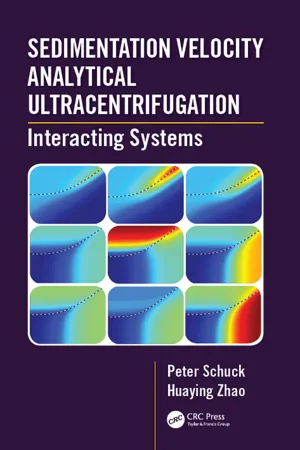
Sedimentation Velocity Analytical Ultracentrifugation
Interacting Systems
- 271 pages
- English
- ePUB (mobile friendly)
- Available on iOS & Android
About This Book
Analytical ultracentrifugation is one of the most powerful solution techniques for the study of macromolecular interactions, to define the number and stoichiometry of complexes formed, and to measure affinities ranging from very strong to very weak and repulsive.
Building on the data analysis tools described in the volume Sedimentation Velocity Analytical Ultracentrifugation: Discrete Species and Size-Distributions of Macromolecules and Particles, and the experimental and instrumental aspects in the first volume Basic Principles of Analytical Ultracentrifugation, the present volume Sedimentation Velocity Analytical Ultracentrifugation: Interacting Systems is devoted to the theory and practical data analysis of dynamically coupled sedimentation processes.
This volume is designed to fill a gap in biophysical methodology to provide a framework that builds on the fundamentals of the highly developed traditional methods of analytical ultracentrifugation, updated with current methodology and from a viewpoint of modern applications. It will be an invaluable resource for researchers and graduate students interested in the application of analytical ultracentrifugation in the study of interacting systems, such as biological macromolecules, multi-protein complexes, polymers, or nanoparticles.
Frequently asked questions
Table of contents
- Cover
- Half Title
- Title Page
- Copyright Page
- Dedication
- Table of Contents
- Foreword
- Preface
- Symbol Description
- CHAPTER 1 ▪ Exact Description of Ideally Sedimenting Associating Systems
- CHAPTER 2 ▪ Phenomenology of Sedimentation of Interacting Systems
- CHAPTER 3 ▪ Approximate Solutions for the Coupled Lamm Equations of Reacting Systems
- CHAPTER 4 ▪ Sedimentation Coefficient Distributions
- CHAPTER 5 ▪ Nonideal Sedimentation Velocity
- CHAPTER 6 ▪ Practical Analysis of Interacting Systems
- APPENDIX A ▪ Numerical Solution of Coupled Systems of Lamm Equations for Interacting Systems
- APPENDIX B ▪ Effective Particle Theory for Multi-Component Systems
- Bibliography
- Index